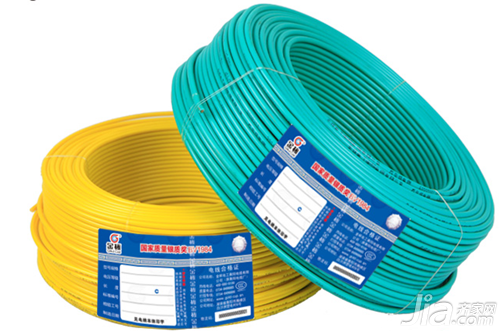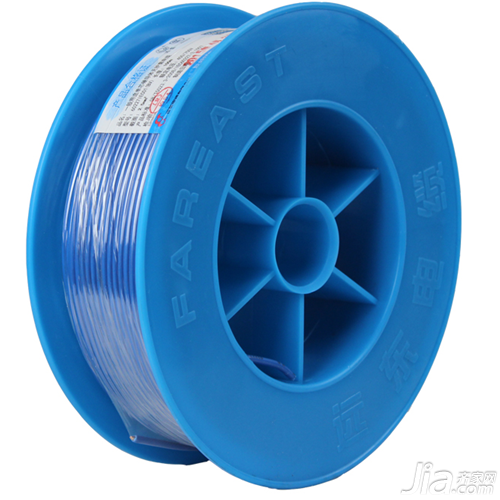Wires are wires that conduct current. Every household can't leave a wire. In other words, there must be a wire wherever there is electricity or current. In order to be safe, choose the electric wire at home must choose very good. Next the small series makes everybody understand the wire thickness knowledge and the thickness of the electric wire and the size of the electric current how to count the related content.

1. The relationship between the current carrying capacity and the cross section of insulated wire of aluminum core
10 under five hundred two,
25, 35, four, three circles,
70, 95, two and a half times,
Wear tube, temperature, 80% off.
Bare line plus half,
Copper upgrade calculation.
2. Note that the ampacity does not directly indicate the ampacity of various cross-sections, but is expressed by multiplying the cross-section by a certain multiple. For this purpose, the nominal cross-sections (square millimeters) of commonly used conductors in China are arranged as follows:
1, 1.5, 2.5, 4, 6, 10, 16, 25, 35, 50, 70, 95, 120, 150, 185...
(1) The first sentence indicates that the current carrying capacity of the aluminum core insulated wire (A) can be calculated as a multiple of the cross section. Arabic numerals in the mouth indicate wire cross-section
(Square mm), the number of Chinese characters indicates a multiple. The relationship between the cross section of the mouth and the multiples is as follows:
1 ~ 10 16, 25 35, 50 70, 95 120 or more
{ } { } { }
Five times four times three times two and a half times
It is now even clearer to speak with your mouth. The “10 under 5†in the mouth means that the cross section is below 10, and the current carrying capacity is five times that of the cross section. "100 on the second" (read the second on the second) refers to more than 100 cross-section of the ampacity is the cross-sectional value of twice. Sections 25 and 35 are four and three times the boundaries. This is the word "25, 35, four or three circles." The sections 70 and 95 are 2.5 times. From the above arrangement, it can be seen that except for 10 or more and 100 or more, the middle wire cross section is the same multiple of each two specifications.

For example, when the ambient temperature is not greater than 25°C, the calculation of the current-carrying capacity of the aluminum-core insulated wire is as follows:
When the section is 6 square millimeters, calculate the current carrying capacity is 30 A;
When the section is 150 square millimeters, the calculated current-carrying capacity is 300 amps;
When the cross section is 70 square millimeters, the current carrying capacity is 175 amps.
From the above arrangement, it can also be seen that the multiple decreases with the increase of the cross section, and the error is slightly larger at the transition of the multiple change. For example, sections 25 and 35 are four times and three times the boundaries, and 25 are four times the range. It is calculated as 100 amps, but the manual is 97 amps, and 35 is the opposite, and the verb is calculated as 105 amps. The check list is 117 amps. However, this has little effect on use. Of course, if you can "get in the chest," when choosing a conductor section, 25 will not allow it to reach 100 amps, and 35 will be slightly more than 105 ampere. Similarly, 2.5 square millimeters of wire is five times the beginning of the actual end, it is more than five times (up to more than 20 amps), but in order to reduce the power loss in the wire, the current is usually not so large, the manual is generally only 12 security.
(2) The last three sentences are the treatment of changes in conditions. “Through pipe, temperature, eighty percent and ninety percent off†means: If the pipe is laid (including the laying of slot boards, ie, the conductors are covered with protective jackets, uncovered), the calculation will be followed by a discount of 20%; if the ambient temperature exceeds 25 °C, after the calculation, you will get a 10% discount. If you wear a tube and the temperature exceeds 25°C, you will have to play it after 20% discount, or simply press 70% off.
With regard to the ambient temperature, it is defined as the average maximum temperature of the hottest months in summer. In fact, the temperature changes, and in general, it does not affect the wire carrying capacity. Therefore, discounts are only considered when certain high-temperature workshops or hotter areas exceed 25°C.

For example, the calculation of the downloaded flux of aluminum core insulated wire under different conditions:
When the cross-section is 10 square millimeters, the current-carrying capacity is 10×5×0.8=40 amps; if the temperature is high, the current-carrying capacity is 10×5×0.9=45 amps; if the tube is high temperature, the current-carrying capacity is 10 ×5×0.7=35 amps.
(3) For the current carrying capacity of bare aluminum wire, the port says "plus one half of the bare wire," which is calculated by adding half. This means that the same sectional bare aluminum wire is compared with the aluminum core insulated wire and the current carrying capacity can be increased by half.
For example, the calculation of the current capacity of bare aluminum wire:
When the cross section is 16 square millimeters, the current carrying capacity is 16*4*1.5=96 amps. If the temperature is high, the current carrying capacity is 16*4*1.5*0.9=86.4 amps.
(4) For the copper conductor's current carrying capacity, the port indicates "copper wire upgrade calculation", that is, the cross section of the copper conductor is arranged in cross-section.
Increase the order by one step and calculate the corresponding aluminum conditions.
For example, a bare copper wire with a cross-section of 35mm2 has an ambient temperature of 25°C. The calculation of the current-carrying capacity is: 50mm3 x 1.5 = 225 amps for an upgraded bare aluminum wire of 50mm2.
For cable, there is no description in the mouth. Generally directly buried high voltage cables can be directly calculated using the relevant multiples in the first statement. For example, a 35mm square high-voltage armoured aluminum core cable has a current-carrying capacity of 35 x 3 = 105A. 95 square millimeters is approximately 95×2.5 inches and 238 amps.
The section of the zero line in a three-phase four-wire system is usually selected to be about 1â„2 of the phase section. Of course it must not be less than the minimum cross section allowed by the mechanical strength requirements. In a single-phase line, since the load currents passed by the neutral line and the phase line are the same, the cross-section of the zero line should be the same as the cross-section of the phase line.

The following is a list of words:
Insulated wire flux estimation
Multiplication relationship between current carrying capacity and cross section of aluminum core insulated wire
Conductor cross section (mm 2 ) 1 1.5 2.5 4 6 10 16 25 35 50 70 95 120
The current carrying capacity is the multiple of 9 8 7 6 5 4 3.5 3 2.5
Current carrying capacity (A) 9 14 23 32 48 60 90 100 123 150 210 238 300
Estimates: 2:5, multiply by 9, and go up one minus. Thirty-five to three-by-five, and both teams lose five points. The conditions are changed and converted, and the high temperature 10% copper upgrade. The number of pipes worn was 234, and the full load was 876. Explanation: (1) The current-carrying capacity (safety current) of various insulated wires (rubber and plastic insulated wire) in this section is not directly indicated, but is expressed by “multiply the cross-section by a certain multiple†and is calculated by mental arithmetic. It can be seen from Table 53 that the multiple decreases with the increase of the cross section. “Five to multiply by two at five and nine at a time, and one at a time to go upwards†refers to various sections of aluminum-core insulated wires of 2.5 mm′ or less, whose current carrying capacity is approximately 9 times the number of sections. Such as 2.5mm' wire, the current capacity of 2.5 × 9 = 22.5 (A). The multiple of the current carrying capacity and the number of cross-sections of the conductors from 4 mm′ and above is the row along the line number, and the multiple is successively reduced by l, that is, 4×8, 6×7, 10×6, 16×5, and 25×4. "Thirty-five-by-three and five-points, both in groups minus five," said 35mm" wire carrying capacity is 3.5 times the number of sections, that is 35 × 3.5 = 122.5 (A). For a conductor of 50mm' or more, the multiple relationship between the current carrying capacity and the number of sections becomes a group of two two wire numbers, and the multiple is reduced by 0.5. That is, the current carrying capacity of the 50 and 70mm' wires is the number of sections. Times; 95,120mm" wire carrying capacity is 2.5 times its cross-sectional area, and so on. "Conditions are subject to change, high temperature 10% copper upgrade". The above-mentioned mouthpiece is made of an aluminum core insulated wire and an open coating under the condition of an ambient temperature of 25°C. If the aluminum core insulation wire is deposited in an area where the ambient temperature is higher than 25°C for a long time, the wire carrying capacity can be calculated according to the above formula, and then it can be used for 10%. When the aluminum wire is used instead of the aluminum wire, the copper core wire is used. Its ampacity is slightly larger than that of the aluminum wire of the same specification. The ampacity method can be used to calculate the ampacity of a line number larger than that of the aluminum wire. For example, the current carrying capacity of 16mm' copper wire can be calculated as 25mm2 aluminum wire.

Xiao Bian concludes : The relevant content of the wire thickness knowledge is introduced to this and I hope to help you. More exciting information is on this site.
Wire Switch Wire Optional Wire Decoration Wire Brand Wire Plug
R15 Stainless Steel Kitchen Sink
Stainless Sink,Stainless Steel Double Sink,Stainless Steel Kitchen Sink,Stainless Steel Farm Sink
SUNRISE HOME GOODS(M)SDN.BHD. , https://www.sunrisesink.com